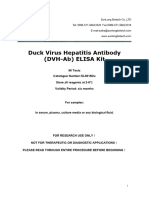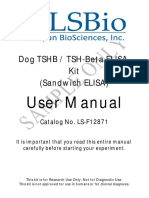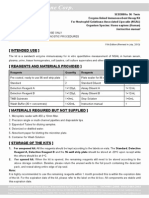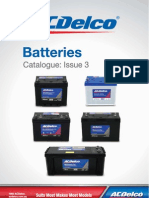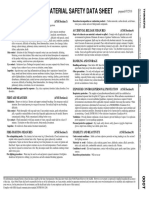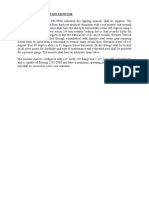MBS266897
MBS266897
Uploaded by
mahmoudarif2020Copyright:
Available Formats
MBS266897
MBS266897
Uploaded by
mahmoudarif2020Original Title
Copyright
Available Formats
Share this document
Did you find this document useful?
Is this content inappropriate?
Copyright:
Available Formats
MBS266897
MBS266897
Uploaded by
mahmoudarif2020Copyright:
Available Formats
Manuals version :04.10.
2021
Rat Superoxide Dismutases (SOD)ELISA Kit
Cat No. MBS266897
This product is suitable for the in vitro quantitative detection of Rat serum, plasma or cell
culture supernatant and organizations in the natural and recombinant SOD concentration. For
detection of other special sample types please contact our technical support. The kit is for
Research Use Only. Please read the instructions carefully before using and confirm all kit
components are included.
This kit employs the “Double Antibody Sandwich” technique. The principle of Double
Antibody Sandwich is based on the characteristics of a target analyte with more than two
possible epitopes which can be identified by both the pre-coated capture antibody and the
om
detection antibody simultaneously. The process is as follows:
1. Pre-coat antibodies to the plate, and then, via washing, remove all antibodies and
.c
impurities that did not bind to the plate. The remaining sites on the plate are blocked with
irrelevant proteins. ce
2. Once remaining plate sites have been blocked, sample containing the target analyte can be
added, which will result in the target analyte becoming immobilized by the
ur
analyte-specific capture antibodies, forming an antigen-antibody complex. The wells
are then washed to remove all unbound particles and impurities.
So
3. A biotin-labeled antibody is then added to the wells that is also specific for the target
analyte, resulting in an antibody-antigen-antibody complex. The plate is again washed to
remove unbound antibodies and impurities.
io
4. Next, horseradish peroxidase + avidin is added to the wells and binds with the
biotin-labeled antibodies. The quantity of reporter enzyme is now positively correlated to
yB
the quantity of target analyte in the sample. The wells are then washed again to remove
any impurities.
M
5. Finally, substrates for the HRP reaction are added, and the sample concentrations can then
be computed/calculated from the resulting coloration changes.
Note: Antibodies can be labeled with multiple biotin molecules, which can bind to HRP-Avidin and
result in multiple HRP complexes per antibody. This tends to show higher sensitivity and
amplification effects compared to traditional direct HRP-Antibodies.
【Detection principle of Rat Superoxide Dismutases (SOD)ELISA kit】
As mentioned above, this kit utilizes the Double Antibody Sandwich ELISA technique. The
pre-coated antibody is an anti-Rat SOD monoclonal antibody, while the detection antibody is
a biotinylated polyclonal antibody. Samples and biotinylated antibodies are added into ELISA
plate wells and washed out with PBS or TBS after their respective additions to the wells.
Then Avidin-peroxidase conjugates are added to the wells in after. TMB substrate is used
for coloration after the enzyme conjugate has already been thoroughly washed out of the
-1-
** FOR RESEARCH USE ONLY. NOT FOR USE IN DIAGNOSTIC PROCEDURES.**
wells by PBS or TBS. TMB reacts to form a blue product from the peroxidase activity, and
finally turns to yellow after addition of the stop solution (Color Reagent C). The color
intensity and quantity of target analyte in the sample are positively correlated.
General Schematic of the Double-Antibody Sandwich Principle:
The first step The second step
The third step The fourth step
om
.c
ce
【Kit Components】
ur
Name 96 Tests 48 Tests Storage
So
Pre-coated plate 8×12 8×6 4/-20℃
Rat SOD Standards 2 vial 1 vial 4/-20℃
Biotinylated antibody (1:100) 1vial 1 vial 4/-20℃
io
Enzyme conjugate(1:100) 1vial 1 vial 4/-20℃
Enzyme diluent 1vial 1 vial 4/-20℃
yB
Antibody diluent 1vial 1 vial 4/-20℃
Standard diluent 1vial 1 vial 4/-20℃
M
Sample diluent 1vial 1 vial 4/-20℃
Washing buffer (1:25) 1vial 1 vial 4/-20℃
Color Reagent A 1vial 1 vial 4/-20℃
Color Reagent B 1vial 1 vial 4/-20℃
Color Reagent C 1vial 1 vial 4/-20℃
Manual 1 set 1 set RT
Notes:
RT:Room temperature
Standard:Lyophilized
Color Reagent A: Avoid light
【Materials Required But Not Provided With Kit】
1. Microplate reader (450nm detection wavelength filter, with optional 570nm or 630nm
-2-
** FOR RESEARCH USE ONLY. NOT FOR USE IN DIAGNOSTIC PROCEDURES.**
correction wavelength filters).
2. Washer (adjustable injection volume to ensure that each well receives 350μl without
overflow).
3. Clean benches, biological safety cabinets, fume hoods.
4. High-precision single-channel pipette (range 0.5-10μl-20μl, 20-200μl, 200-1000μl).
5. High-precision multi-channel pipette (8 or 12, the range of 50-300μl of).
6. 37℃ incubator.
7. Low temperature centrifuge.
8. Refrigerators (4℃, -20℃, -86℃).
9. Analytical balance.
10. Scissors, tweezers, pliers, etc.
11. Plate mixer, low-frequency oscillator, etc.
【Additional Materials Required】
om
1. Centrifuge tubes (capacity of 1.5ml, 5ml, etc.).
2. Disposable pipette tips (range of 0.5-10μl-20μl, 20-200μl, 200-1000μl).
3. Pure water or distilled water.
.c
4. Coordinate paper.
5. Absorbent paper. ce
【Sample collection Note】
1. Blood collection tubes should be both pyrogen- and endotoxin-free.
ur
2. Hemolyzed or hyperlipidemic specimens are not recommended to be used.
3. Samples ultimately should appear clear and mostly transparent. All particulates should be
So
removed through centrifugation.
4. If collected samples are not used immediately, they should be divided according to single
io
usage quantities and stored frozen at -20-80℃, carefully avoiding repeated freeze-thaw
cycling.
yB
5. Sample dilution optimization is often necessary for proper sample resolution within the
standard curve. Pre-experiments are always recommended to be performed prior to
running the bulk of the samples, in order to determine if an optimizing dilution should be
M
made to the samples.
6. It is recommended to collect sufficient samples for running multiple tests, since
sometimes some users can experience issues that may result in a loss of data.
7. Always wear protective outerwear while collecting/handling samples (e.g. wearing
gloves, coat, respirator, etc.) and be aware of all potential risks involved in handling
your specimens.
8. Specimen processing should be conducted inside a properly-maintained biological safety
cabinet.
【Sample Preparation】
1. Serum: Place collected whole blood in refrigerator at 4℃ overnight. Then centrifuge for
10min at 1000-3000rpm. Take supernatant and either test immediately or place samples
at -20℃/-80℃(1-3 months) for storage.
-3-
** FOR RESEARCH USE ONLY. NOT FOR USE IN DIAGNOSTIC PROCEDURES.**
2. Plasma: Take plasma where EDTA, sodium citrate, or heparin has been added as
anticoagulant. Mix well. Centrifuge mixture for 10min at 1000-3000rpm.
Take supernatant and test immediately or place samples at -20℃ /-80℃ (1-3 months) for
storage.
3. Tissue homogenate: Take tissue slices which have been washed in 0.01M PBS and then a
tissue protein extraction reagent has been added according to proportion of 1g to 5-10mL
and then mixed on ice bath. After sufficient homogenization, please then centrifuge for
10min at 5000-10000rpm. Take supernatant for immediate testing, or place samples at
-20℃/-80℃ (1-3 months) for storage.
4. Cell culture: Centrifuge for 10min at 1000-3000rpm. Take supernatant for immediate
testing, or place samples at -20℃/-80℃ (1-3 months) for storage.
5. For urine, ascites, cerebrospinal fluid, etc: Centrifuge for 10min at 1000-3000rpm. Take
supernatant for immediate testing, or place samples at -20℃/-80℃ (1-3 months) for
storage.
om
Note: It is recommended that the user be well-informed regarding the general range of
concentrations that are expected for their samples. We would suggest consulting the
scholarly literature for references to similar samples’ concentrations, and then to consider
.c
diluting your samples accordingly.
【Note】
ce
1. The re-dissolved standard cannot be stored again once prepared, so please do not attempt
to re-freeze it once it has been reconstituted.
ur
2. Due to shaking/inversion during transport, centrifuging of the tubes/bottles of the kit might
be necessary to consolidate the material contained within. Tubes should be shaken
So
manually or centrifuged for 1 min at 1000rpm to pool all material to the bottom.
3. Concentrated washing buffer might crystallize slightly. Use a water bath to help the
io
dissolution during diluting process. The crystals must be totally dissolved when preparing
the washing buffer.
yB
4. The prepared standard is intended to only be a single-use aliquot, so please do not try to
re-use the standard that has already been tested. Please use the second vial provided if
you run the assay again.
M
5. Only use reagents/components that came directly with this kit. Do not mix batches/lots
from other orders of this kit, or from different kits.
6. Ensure the reagents are well mixed. For the reagents in the microplate, adequate mixing
is particularly important for accurate test results. It is recommended to employ a
micro-oscillator (at the lowest frequency). If a micro-oscillator is not available, please
slightly shake the microplate manually for 1 min, in a circular motion in order to make
sure the wells are sufficiently mixed.
7. Please ensure the kit has been brought to room temperature prior to beginning the assay.
8. Standards are always recommended to be tested in duplicate or triplicate.
9. Place the unused microplate strips into the foil bag at 2-8℃ for storage (if you intend to
use the strips within a relatively short timeframe).
10. The chromogen reagent is sensitive to light, therefore please avoid exposing to light.
11. Kits that have passed their expiration date should not be used.
-4-
** FOR RESEARCH USE ONLY. NOT FOR USE IN DIAGNOSTIC PROCEDURES.**
12. When using dual-wavelength, the wavelengths should be set at 450nm and 630nm.
13. All the samples, washing buffer and wastes should be treated as biowaste. Color Reagent
C is 1M sulfuric acid, so please pay close attention to safety when it is used.
14. Sample addition should always be done via pipette or similar instrument. Calibrate the
instrument prior to running the assay in order to avoid experimental errors. Please add
samples to the wells quickly, as it is recommended to control the sample addition time to
less than ~5 minutes. You might want to consider multi-pronged pipettes if this helps
with the loading time.
15. Do not re-use the adhesive strips. Cut them to size if you only use part of the plate at a
time. Always discard after use.
16. New standard curves should be made for every new run of the assay. If the observed
concentrations of test samples are too high (OD value of the sample is higher than that of
standard well maximum concentration), dilute by a certain factor, and correct for said
factor in the end calculations.
om
17. Samples containing NaN3 cannot be tested due to NaN3 inhibiting the activities of
horseradish peroxidase (HRP).
18. When washing plate via plate washer, the volume of buffer injected into each well should
.c
be slightly more than 350μl. Make sure the sampling head is not jammed or blocked. Also,
if washing by hand, please take care when using an absorbent material to remove excess
ce
water – make sure this absorbent material wasn’t used to clean any of the other reagents
to prevent contamination.
19. After the coloration reaction termination by Color Reagent C, please read OD within 10
ur
minutes.
20. If duplicate wells were performed, the mean value of the wells should be used.
So
21. Hemolyzed samples may cause false positive results, so we consider these samples to be
incompatible with this kit.
io
22. During the assay, please try to control the humidity to ~60%.
23. We recommend regularly checking the thermostat and calibration in order to confirm the
yB
incubation temperature remains at a stable 37℃.
24. For the 48T ELISA Kit, all components are 50% the amount of those in the 96T.
M
【Test preparation】
1. Please remove ELISA Kit from refrigerator 20 minutes in advance, and begin test once it
has been brought to room temperature.
2. Dilute the concentrated washing buffer with double distilled water (1:25). Return unused
quantity back to the box.
3. Standard: Add 1.0ml Standard Diluent to lyophilized standard vial and allow to sit for 30
min. After the standard has completely dissolved, mix it slightly and mark with a label on
the tube. It is recommended to use the following concentration values for the standard
curve: 500, 250, 125, 62.5, 31.2, 15.6,7.8U/mL. Note: Make absolutely sure the
lyophilized standard completely dissolved and well mixed.
4. Legend of standard sample dilution method: Take 7 clean tubes and label them with their
expected concentrations (250, 125, 62.5, 31.2, 15.6, 7.8,0U/mL). Add 300μL Standard
Diluent into each tube. Pipette out 300μl diluent from the reconstituted standard and add to
-5-
** FOR RESEARCH USE ONLY. NOT FOR USE IN DIAGNOSTIC PROCEDURES.**
the tube labeled 250U/mL and mix well. Further Pipette out 300μl diluent from the
250U/mL tube, and add to the 125U/mL, and mix well. Repeat these steps through the
7.8U/mL standard. Standard Diluent in the 0U/mL tube is the negative control.
Note: The reconstituted standard solution(500 U/mL)should be discarded after running the
assay – it is not reusable.
om
.c
Note: Reconstituted standard stock solution cannot be reused.
ce
5. Biotinylated Antibody: Remove the appropriate volume of Biotinylated Antibody solution
for the quantity of wells intending to be assayed, and dilute with Antibody Diluent in a
ur
proportion of 1:100. This should be prepared 30min in advance, and we would absolutely
recommend not re-using for additional assaying.
So
6. Enzyme Conjugate: Remove the appropriate amount of Enzyme Conjugate solution for the
quantity of wells intending to be assayed, and dilute with the Enzyme Diluent in a
proportion of 1:100. This should be prepared 30min in advance, and we would absolutely
io
recommend not re-using for additional assaying.
7. Color Reagent: Prepare Color Reagent solution 30min in advance by adding Color Reagent
yB
A and Color Reagent B by the proportion of 9:1.
【Washing method】
M
1. Automatic plate-washing: The required amount of wash buffer is 350μl, and the injection
and extraction intervals should be ~20-30secs. Please be well aware of the operation
before putting the machine into practice.
2. Manual plate-washing: add 350μl wash buffer to each well and let stand for 30sec. Shake
plate to remove as much liquid as possible, and dab the plate with absorbent paper if
necessary. During the plate-washing process, please pay close attention to the wash
buffer-adding steps to avoid contamination and well-jumping.
【Steps】
1. Remove number of strips desired, and allow to acclimate to room temperature. The unused
strips and desiccant should be placed back into the sealed aluminum foil bag and stored at
2-8℃.
2. Set aside blank wells (if measuring at dual-wavelength, the blank wells can be ignored)
-6-
** FOR RESEARCH USE ONLY. NOT FOR USE IN DIAGNOSTIC PROCEDURES.**
3. Add standards or samples to their corresponding wells (100μL for each well). Please
remember that the 0U/mL well should be 100μL of Standard Diluent. Seal the
wells/plate with the adhesive tape strip, and incubate at 37℃ for 90min.
4. Prepare required quantity of Biotinylated Antibody 30min in advance.
5. Wash ELISA plate 2 times
6. Add prepared Biotinylated Antibody to each well (100μL per well). Seal reaction wells
with adhesive tape strip, and incubate at 37℃ for 60min.
7. Prepare required quantity of Enzyme Conjugate 30min in advance.
8. Wash ELISA plate 3 times
9. Add prepared Enzyme Conjugate to each well other than the blank wells (100μl for each).
Seal the wells with the adhesive tape strip, and incubate at 37℃ for 30min.
10. Wash ELISA plate 5 times.
11. Add 100μL of the prepared Color Reagent to individual wells (also into blank well),
incubate protected from light at 37℃. When the coloration of the highest standards
om
become darker, and the color gradient appears, the incubation can be stopped. The
chromogenic reaction should be controlled to within 30 min.
12. Add 100μL Color Reagent C to each individual well (also into blank well). Mix well.
Read OD(450nm)within 10 min.
.c
【Result determination】
ce
1. The OD values of each sample and standard should have the values of the blank well
subtracted.
ur
2. Draw standard curve manually. Take the concentration values of standards as X- and OD
readings as the Y-coordinates. Use a smooth line to connect each coordinate point of the
So
standard values. The concentration of samples can be found by inputting the sample OD
values into the line equation for the standard curve. It is recommended to employ
io
professional curve software (e.g. curve expert 1.3) to analyze and compute the results.
3. If the sample OD is higher than that of the highest standard in standard curve, the sample
yB
should be diluted (or diluted further) and the assay reran. Multiply the results by the
dilution factor when calculating for the unknown.
Note: This chart is only for reference. Calculation of user sample content should always be
M
subject to the standard curve made during the same experiment
【Reference curve】
-7-
** FOR RESEARCH USE ONLY. NOT FOR USE IN DIAGNOSTIC PROCEDURES.**
Note: Again, please not that his chart is for reference only, and that user sample concentrations should be
based on the standard curve generated at the same time as their samples on the same plate.
【Summary of operating procedures】
step Summary of operating procedures
1 Prepare reagents, samples and standards.
2 Add the prepared samples and standard & incubate at 37 ℃ for 90 minutes.
3 Wash 2x, add Biotinylated Antibody solution & incubate at 37 ℃ for 60
minutes.
4 Wash 3x, then add the Enzyme working solution & incubate at 37 ℃ for 30
minutes.
5 Wash 5x, then add the Color Reagent solution & incubate at 37 ℃ up to 30
minutes.
6 Add the Color Reagent C.
om
7 Use microplate reader to measure OD within 10 minutes of adding Color
Reagent C.
8 Calculate the content of samples being tested
.c
【Detection range】500 U/mL-7.8 U/mL ce
【Sensitivity】the minimum detectable Rat SOD up to 1 U/mL.
【Intra assay Precision】≤ 8%
ur
【Inter assay Precision】≤ 12%
【Recovery】70 - 110 percent.
So
【Storage】-20℃ [Short-term should be stored at 4℃(such as ~2 weeks)]
【Uses】used for in vitro quantitative analysis of liquid medium samples (Universal).
【Specifications】96T.
io
【Production Date】See microtiter plates aluminum foil bag sealing stamp.
【Validity】12 months (-20℃).
yB
【Reference】
M
1. Borgstahl GE, Parge HE, Hickey MJ, Johnson MJ, Boissinot M, Hallewell RA, Lepock JR,
Cabelli DE, Tainer JA (April 1996).
2. McCord JM, Fridovich I (1988).
3. Brewer GJ (September 1967).
4. Tainer JA, Getzoff ED, Beem KM, Richardson JS, Richardson DC (September 1982).
5. Richardson JS, Thomas KA, Rubin BH, Richardson DC (1975).
6. Tainer JA, Getzoff ED, Richardson JS, Richardson DC (1983).
-8-
** FOR RESEARCH USE ONLY. NOT FOR USE IN DIAGNOSTIC PROCEDURES.**
You might also like
- ChemDraw Tutorials (Basic & Adv Drawing) PDFDocument54 pagesChemDraw Tutorials (Basic & Adv Drawing) PDFThe Negative AngleNo ratings yet
- Epdm Mold FoulingDocument12 pagesEpdm Mold Foulingcronorom100% (1)
- Mbs 267431Document8 pagesMbs 267431Lễ Phan ThịNo ratings yet
- SL0017 DuDocument6 pagesSL0017 DuSales DiagindoNo ratings yet
- SL0018 DuDocument6 pagesSL0018 DuSales DiagindoNo ratings yet
- User Manual: Dog TSHB / Tsh-Beta Elisa Kit (Sandwich ELISA)Document22 pagesUser Manual: Dog TSHB / Tsh-Beta Elisa Kit (Sandwich ELISA)Julio Cesar MaceNo ratings yet
- Human Interleukin 18, IL18 MBS2020065 MyBiosourceDocument8 pagesHuman Interleukin 18, IL18 MBS2020065 MyBiosourceA. Arviani Desianti NurNo ratings yet
- ELISA Kit For Vitamin D3 (VD3) CEA920GeDocument9 pagesELISA Kit For Vitamin D3 (VD3) CEA920Gebambang purwantoNo ratings yet
- Elisa MethodDocument7 pagesElisa MethodNandia SeptiyoriniNo ratings yet
- ELISA Kit For Angiotensin II (AngII) E90005RaDocument8 pagesELISA Kit For Angiotensin II (AngII) E90005RaTan Jie HuiNo ratings yet
- Mbs 2707324Document8 pagesMbs 2707324mahmoudarif2020No ratings yet
- ELISA Kit For Hepatocyte Growth Factor (HGF) SEA047HuDocument9 pagesELISA Kit For Hepatocyte Growth Factor (HGF) SEA047HuLink ZeldaNo ratings yet
- Manual ANA ElisaDocument10 pagesManual ANA ElisaDaniel Mojica VegaNo ratings yet
- Rat IL-10_(Cusabio)Document14 pagesRat IL-10_(Cusabio)j.renaudmenangaNo ratings yet
- CSB E13415hDocument14 pagesCSB E13415hhuripNo ratings yet
- ELISA Kit For Fetoprotein Alpha (AFP) E90153BoDocument8 pagesELISA Kit For Fetoprotein Alpha (AFP) E90153BoRo KohnNo ratings yet
- ELISA Kit For Sirtuin 1 (SIRT1) SEE912HuDocument9 pagesELISA Kit For Sirtuin 1 (SIRT1) SEE912Hufitriani fajriNo ratings yet
- Elisa KitDocument5 pagesElisa KitYani Nyiik0% (1)
- Protocol: 190989 Dentin Sialoprotein (DSP) Bioassay™ Elisa Kit (Human)Document4 pagesProtocol: 190989 Dentin Sialoprotein (DSP) Bioassay™ Elisa Kit (Human)MSKANo ratings yet
- SG-16448 Human V-Type Immunoglobulin Domain-Containing Suppressor of T-Cell Activation (VISTA) ELISA KitDocument4 pagesSG-16448 Human V-Type Immunoglobulin Domain-Containing Suppressor of T-Cell Activation (VISTA) ELISA KitAmrNo ratings yet
- Rat Androgen Receptor (AR) ELISA Kit: Catalog Number. CSB-EL001975RADocument14 pagesRat Androgen Receptor (AR) ELISA Kit: Catalog Number. CSB-EL001975RANandia SeptiyoriniNo ratings yet
- Elk0855 1Document17 pagesElk0855 1Thamer Ahmed ObeidatNo ratings yet
- Human DSP (Dentin Sialoprotein) ELISA KitDocument9 pagesHuman DSP (Dentin Sialoprotein) ELISA Kitmsk adiwiryaNo ratings yet
- SG-10139 Human Tumor Necrosis Factor Ligand Superfamily Member 14 (TNFSF14) ELISA KitDocument4 pagesSG-10139 Human Tumor Necrosis Factor Ligand Superfamily Member 14 (TNFSF14) ELISA KitAmrNo ratings yet
- (Intended Use) : Instruction ManualDocument8 pages(Intended Use) : Instruction ManualTPNo ratings yet
- Mbs 036924Document4 pagesMbs 036924mahmoudarif2020No ratings yet
- Feline FGF 23 Kit ManualDocument4 pagesFeline FGF 23 Kit ManualanninhabandpotterNo ratings yet
- NF KBDocument14 pagesNF KBBIOKITS BIOTECHNOLOGYNo ratings yet
- Mouse IL-8 (Interleukin 8) ELISA Kit: Instruction ManualDocument9 pagesMouse IL-8 (Interleukin 8) ELISA Kit: Instruction ManualAak An NasherNo ratings yet
- Human PSA (Prostate Specific Antigen) ELISA Kit: 8th Edition, Revised in October, 2018Document12 pagesHuman PSA (Prostate Specific Antigen) ELISA Kit: 8th Edition, Revised in October, 2018audrey mappyNo ratings yet
- (Intended Use) : Instruction ManualDocument8 pages(Intended Use) : Instruction ManualNitin KeshavNo ratings yet
- ELISA Kit For Transforming Growth Factor Beta 1 (TGFb1) SEA124HuDocument10 pagesELISA Kit For Transforming Growth Factor Beta 1 (TGFb1) SEA124Hufaisal khanNo ratings yet
- MBS029209Document4 pagesMBS029209DianaNo ratings yet
- SG-15702 Human Killer Cell Immnoglobulin Like Receptor (KIR) ELISA KitDocument4 pagesSG-15702 Human Killer Cell Immnoglobulin Like Receptor (KIR) ELISA KitAmrNo ratings yet
- Elk4976 1Document17 pagesElk4976 1achmad.thoriqNo ratings yet
- MDA Kits For Rat For Researcher OnlyDocument14 pagesMDA Kits For Rat For Researcher OnlyPritta TaradipaNo ratings yet
- SG-15714 Human Adenosine A2a Receptor (ADORA2A) ELISA KitDocument4 pagesSG-15714 Human Adenosine A2a Receptor (ADORA2A) ELISA KitAmrNo ratings yet
- Rat PDGF (Platelet-Derived Growth Factor) ELISA Kit: Instruction ManualDocument9 pagesRat PDGF (Platelet-Derived Growth Factor) ELISA Kit: Instruction ManualSigit Harya HutamaNo ratings yet
- Canine Adipocytokine Zinc Alpha 2 Glycoprotein (ZAG) Elisa KitDocument13 pagesCanine Adipocytokine Zinc Alpha 2 Glycoprotein (ZAG) Elisa KitMihael DraksicNo ratings yet
- MBS9305901Document4 pagesMBS9305901Ahmed AliNo ratings yet
- Elabscience: (For Research Use Only. Do Not Use It in Clinical Diagnostics !)Document11 pagesElabscience: (For Research Use Only. Do Not Use It in Clinical Diagnostics !)Rachmi FadillahNo ratings yet
- QS0009 MKDocument8 pagesQS0009 MKSales DiagindoNo ratings yet
- Homocysteine ELISA KIT PDFDocument14 pagesHomocysteine ELISA KIT PDFRidwan AndragunaNo ratings yet
- Kit Insert Anti Toxoplasma Gondii IgGDocument13 pagesKit Insert Anti Toxoplasma Gondii IgGAghnia Asy S.No ratings yet
- E TO E022 ElabscienceDocument6 pagesE TO E022 ElabscienceZiaf ZedNo ratings yet
- Human Tumor Necrosis Factor Ligand Superfamily Member 14 (TNFSF14) ELISA KitDocument14 pagesHuman Tumor Necrosis Factor Ligand Superfamily Member 14 (TNFSF14) ELISA KitDr-Dalya ShakirNo ratings yet
- Microbiological Test of Medical DevicesDocument5 pagesMicrobiological Test of Medical Devicesbijendra_sinhaNo ratings yet
- (Intended Use) : Instruction ManualDocument8 pages(Intended Use) : Instruction ManualTPNo ratings yet
- SG-11816 Human CD70 Antigen (CD70) ELISA KitDocument4 pagesSG-11816 Human CD70 Antigen (CD70) ELISA KitAmrNo ratings yet
- A TpoDocument4 pagesA TpoJimboreanu György PaulaNo ratings yet
- Human Interleukin 1, IL-1 ELISA KitDocument8 pagesHuman Interleukin 1, IL-1 ELISA KitAkanksha SinghNo ratings yet
- Elisa Salmonella MybiosourchDocument4 pagesElisa Salmonella Mybiosourchadnes maretaNo ratings yet
- ELK8634-1 (2)Document17 pagesELK8634-1 (2)Emmy MonnaNo ratings yet
- MBS025761Document4 pagesMBS025761RispaAndriyaniNo ratings yet
- Eku02086 PiDocument10 pagesEku02086 PiSir BucketheadNo ratings yet
- NERF2Document11 pagesNERF2BIOKITS BIOTECHNOLOGYNo ratings yet
- Norepinephrine (Research) ELISA: For The Quantitative Determination of Norepinephrine in Various Sample Types and VolumesDocument7 pagesNorepinephrine (Research) ELISA: For The Quantitative Determination of Norepinephrine in Various Sample Types and Volumesnomi_intanNo ratings yet
- IL 1βDocument11 pagesIL 1βBIOKITS BIOTECHNOLOGYNo ratings yet
- Rat Tumor Necrosis Factor α (TNF-α) ELISA KitDocument8 pagesRat Tumor Necrosis Factor α (TNF-α) ELISA KitSamuelNo ratings yet
- Rat CD3_Novus BiologicalsDocument11 pagesRat CD3_Novus Biologicalsj.renaudmenangaNo ratings yet
- Human Cytochrome C ELISA Kit Protocol Book v2 Ab221832 (Website)Document28 pagesHuman Cytochrome C ELISA Kit Protocol Book v2 Ab221832 (Website)ieviukasNo ratings yet
- Practical Handbook of Pharmaceutical Chemistry for M.PharmFrom EverandPractical Handbook of Pharmaceutical Chemistry for M.PharmNo ratings yet
- Environmental Chemistry: Presentation: Prof - Dr.Kramat Mehmood Laiba Saeed SP19S2BA034 BS Chemistry (3rd)Document52 pagesEnvironmental Chemistry: Presentation: Prof - Dr.Kramat Mehmood Laiba Saeed SP19S2BA034 BS Chemistry (3rd)Laiba SaeedNo ratings yet
- Testing StandardDocument7 pagesTesting StandardDiego Fernando Pedroza UribeNo ratings yet
- Hydrostatic Test ProucdureDocument21 pagesHydrostatic Test Proucduresamer8saif100% (1)
- Steelmaster+leaflet 2Document8 pagesSteelmaster+leaflet 2wafik.bassilyNo ratings yet
- Catalogue ACDelco BatteriesDocument64 pagesCatalogue ACDelco BatteriesWill Roj100% (3)
- Practice Occupational Safety and Health ProceduresDocument33 pagesPractice Occupational Safety and Health ProceduresGeraldineNo ratings yet
- 000t DC Solvents MsdsDocument3 pages000t DC Solvents MsdsFaldiNo ratings yet
- Formulary Divided D-76 Film DeveloperDocument3 pagesFormulary Divided D-76 Film DeveloperJohann Walter Carpio AcurioNo ratings yet
- Floor Patch Fast CureDocument2 pagesFloor Patch Fast CureStevenFerrelNo ratings yet
- Compressibility of SoilDocument7 pagesCompressibility of SoiljuryNo ratings yet
- Bamboo Fabric Products and UsesDocument7 pagesBamboo Fabric Products and UsesDorin VladNo ratings yet
- Daftar Obat PrekursorDocument2 pagesDaftar Obat PrekursorMuhammad Mulkhan SubhanNo ratings yet
- Electronic PackagingDocument39 pagesElectronic PackagingPaul Matthew Sermo BentorNo ratings yet
- Recent Development in Graphene Technology For Multidiscilinary Properties and Its ApplicationsDocument12 pagesRecent Development in Graphene Technology For Multidiscilinary Properties and Its ApplicationsSrajan GuptaNo ratings yet
- Utilization of Black Liquor As Concrete AdmixtureDocument8 pagesUtilization of Black Liquor As Concrete AdmixtureMuhammad YunusNo ratings yet
- Efflorescence in ConcreteDocument4 pagesEfflorescence in Concretebala subramanyamNo ratings yet
- 1250 GPM Fixed Location MonitorDocument1 page1250 GPM Fixed Location Monitorbrujula24No ratings yet
- Colour Coated SteelDocument6 pagesColour Coated SteelakmullickNo ratings yet
- Rotary Paddle SwitchDocument10 pagesRotary Paddle SwitchPriyanshu GuptaNo ratings yet
- MK4 DMK Stay Cable System Brochure PDFDocument24 pagesMK4 DMK Stay Cable System Brochure PDFIndra MishraNo ratings yet
- Procedure For Calculating Fuel Gas Saturated Lower Heating Value (SLHV)Document3 pagesProcedure For Calculating Fuel Gas Saturated Lower Heating Value (SLHV)Muhammad AsadNo ratings yet
- NEXT - Restricted Substance Standards Manual (Next)Document24 pagesNEXT - Restricted Substance Standards Manual (Next)Dyeing DyeingNo ratings yet
- ABC Tile AdhesiveDocument1 pageABC Tile AdhesiveTeomnerCabreraNo ratings yet
- Flow BY Muhammad Mansoor Bilal: Senior Officer E&IDocument67 pagesFlow BY Muhammad Mansoor Bilal: Senior Officer E&IMuhammad FaizanNo ratings yet
- Zincsul Msds 2Document4 pagesZincsul Msds 2Djody RahmanNo ratings yet
- Cu-PVC-CTS-PVC (NYSY)Document6 pagesCu-PVC-CTS-PVC (NYSY)Fani Dwi PutraNo ratings yet
- The Manufacturing Processes of StaplerSDocument9 pagesThe Manufacturing Processes of StaplerSMahendra DahiyaNo ratings yet
- Aisi S7Document2 pagesAisi S7123vigenNo ratings yet




